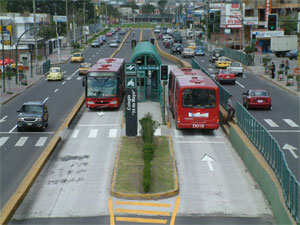Check out this Streetfilms video about Bogota’s TransMilenio BRT system (thanks, Clarence!), narrated by the editor of New York’s Streetsblog, Aaron Naparstek.
I realize that transit geeks and city planners have been singing TransMilenio’s praises for some time now, but I feel compelled to jump on. I love this system. Some highlights:
• Integration: The city operates free feeder buses to take riders from their neighborhoods to the bus stations. Or, riders that would prefer to bike to the stations can travel on the Bogota’s extensive system of bike paths and park their bikes at the station.
• Streamlined boarding: Riders buy tickets at the station instead of on the bus. Also, the bus floor is level with the station platform, which makes it easy for riders with wheelchairs, walkers, strollers, or shopping carts to board.
• Technology: TransMilenio manages the buses from a pretty advanced control room. It allows them to track individual buses, communicate with drivers, and know immediately when buses are crowded or “bunching” (48 style).
From TransMilenio’s Web site:
TransMilenio is a bus rapid transit (BRT) system, designed and implemented according to the following principles:
• By guaranteeing the rendering of urban passenger-transportation services abiding by the highest international standards throughout the entire System, with pre-established timetables in a 365-day basis.
• By making it accessible to low-income users, while at the same time profitable for private operators and fundable by the state.
• By reducing accident rates and decreasing the presence of contamination particle in the city air.
• Respect for the user’s time: By shortening ordinary traveling times by 32%.
• Respect for human diversity: By allowing fair access to all citizens, regardless of their physical, social, economic, gender, and age conditions.
What’s not to love?

